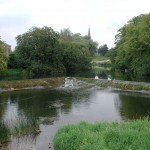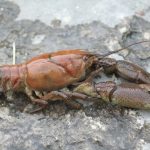'Hydrometrics’ is the measurement of water levels and flow -…
‘Balsam Bashing’ continues along the banks of the River Suir Blueway
‘Balsam Bashing’ is the term used to describe the removal of the plant Himalayan Balsam, which is an invasive alien species in Ireland. Himalayan Balsam is classified as one of the top-ten species to have caused significant environmental impact, especially to river banks here in Ireland.
‘Balsam Bashing’ takes advantage of the shallow root system and delicate stem of the species, this means the plants can be easily pulled and broken, which results in eradication where plants have been pulled.
It is extremely important to do this before the seed pods develop, as any attempt to remove the plant once the seeds have developed will cause the pods to burst, spreading the species further.
This species grows in thick single-plant stands, shading out native plants such as grasses and saplings. Then from October onwards, the balsam plants die back leaving the soil more exposed to weathering and erosion, this is a result of the deliberate shading out of native plants earlier in the year. Himalayan Balsam also produces more nectar in its pink/ purple flowers, than native species, making the plant more attractive to bumblebees, which supports the spread of the species and less pollination of our native plant species.
If this invasive plant continues to spread along the Suir it will lead to degradation and erosion of large sections of river bank. The impact of this will be twofold: firstly, it increases sediment in the water and river bed, which impacts water quality and aquatic life including plants, insects and fish spawning grounds, particularly salmon and trout; secondly the loss of river bank and vegetation will reduce wildlife habitat along the Suir resulting in severe impacts on the local environment and affecting the scenic beauty of the Suir.
Luckily, a group of volunteers decided to act to tackle this invasion of Himalayan Balsam. This group is made up of members of Suircan and Workmans Boat Club. Both groups are based in Clonmel. They were joined by foreign students from Italy and France, together with Andy Griffin from the Experiment in International Living (EIL), a programme that allows students explore the world in an authentic and impactful way through cultural and environmental experiences. Technical support and health and safety awareness was provided by the Local Authority Waters Programme, which is also based in Clonmel. This is a real community effort aimed at protecting the natural environment and wildlife of the Suir. The River Suir is renowned for its natural beauty and was recently launched as a Blueway, this is a major boost for Tipperary and it is sure to attract many visitors over the coming years with its primary resource being the vibrant river Suir and its environs.
This is now the second year of the local initiative and Alan Moore of Suircan confirmed, “Himalyan Balsam plants have been completed eradicated from the locations that were tackled by the volunteers last year”. Shay Hurley of the Workmans Boat Club also commented that he believes “we are winning the war against balsam”.
This is very encouraging and evidence of the successful method being used by the volunteers, which does not involve chemicals or harmful sprays.
“this work is part of an overall strategy to address invasive species in the Suir Catchment, including Giant hogweed and Japanese knotweed, and it links with Tipperary County Council initiatives and ongoing work by other stakeholders and volunteer groups”.
Dr Fran Igoe, Local Authority Waters Programme
It is a collaborative effort, delivering positive results.
Learn more:
If you would like to find out more about this approach or to get involved contact 0761 066 230 or email info@lawaters.ie. Further information about Himalayan Balsam and other invasive species can be found at http://invasivespeciesireland.com











